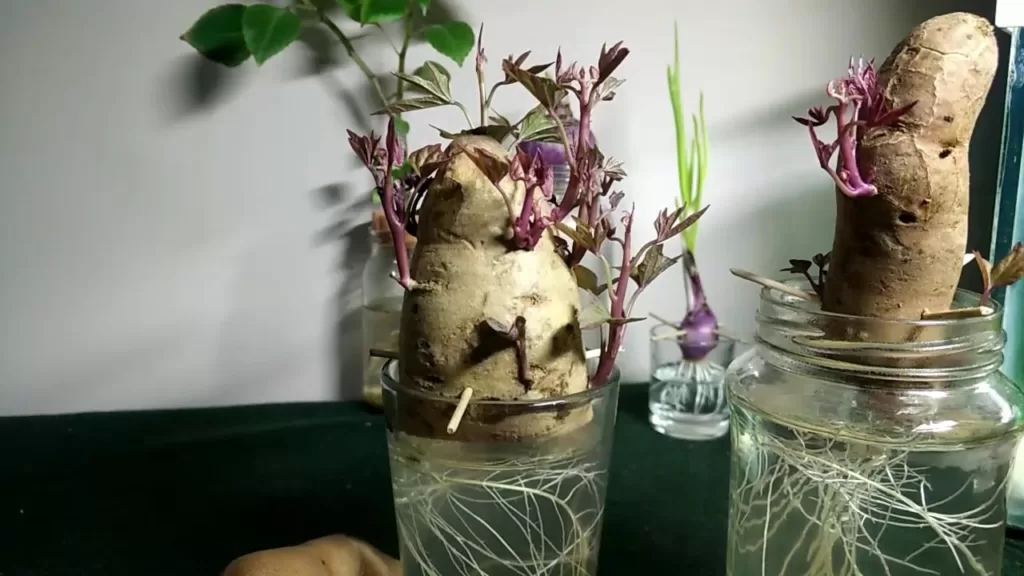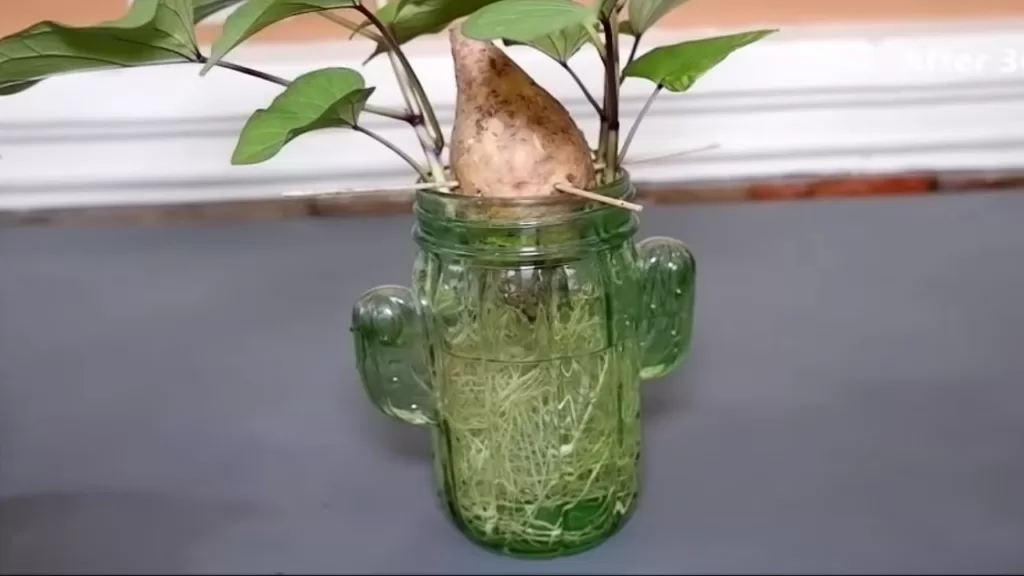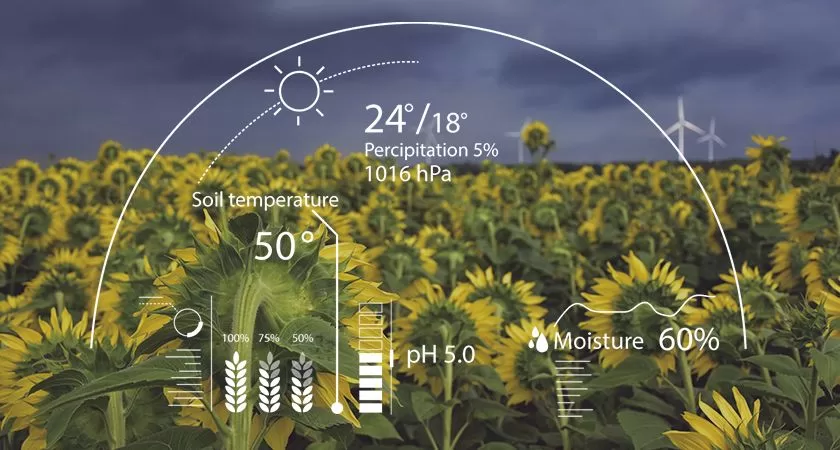Growing sweet potatoes in a jar is a simple and fascinating project that can be accomplished in confined spaces such as a windowsill or a sunny balcony. To begin, select a healthy sweet potato with several “eyes” or sprouts on the surface and place it in a clear jar filled with water, with the bottom half submerged and the top half exposed to air. Keep the jar in the sun and change the water every few days to keep it fresh. You will notice roots and shoots growing from the potato into the water over time. When the shoots are several inches long, transplant the sweet potato to a soil-filled pot or a sunny garden bed. With proper care, your sweet potato plant will produce long vines and eventually mature into delicious sweet potatoes ready for harvest.
Growing sweet potatoes in a jar is a simple and fun project that can be done in a small space. Here are the steps to follow:
- Choose a healthy sweet potato that is large and firm. Look for one with several “eyes” or sprouts on the surface, as these will develop into roots.
- Fill a clear jar with water, leaving about two inches of space at the top.
- Suspend the sweet potato in the jar so that the bottom half is submerged in the water, and the top half is exposed to the air. You can do this by putting toothpicks into the potato and balancing it on the rim of the jar, or by tying a piece of string around the potato and hanging it over the edge of the jar.
- Place the jar in a sunny location and change the water every few days to keep it fresh.
- Within a few weeks, you should see roots and shoots growing from the potato and into the water.
- Once the shoots are several inches long, you can plant the sweet potato in a pot filled with soil, or in a sunny garden bed.
- As the sweet potato grows, it will produce long vines that can be trained to climb a trellis or a support.
- Harvest your sweet potatoes when the leaves begin to yellow and the vines start to wither. They should be ready for harvesting in about three to four months.
Note: Sweet potatoes are warm-weather crops and need a long, warm growing season to reach maturity, so make sure to start them early in the season if you live in a cool climate.

How to choose the right Jar for growing sweet potato
There are several factors to consider when selecting a jar for growing sweet potatoes:
- Transparency: A clear or transparent jar will allow you to see the sweet potato roots and shoots growing, which can be a fun and educational experience.
- Jar Size: Select a jar large enough to hold the sweet potato while leaving about two inches of space at the top for the water. For most sweet potatoes, a quart-sized jar is sufficient.
- Material: Glass jars are commonly used for growing sweet potatoes, but any jar that is safe for food and water, such as ceramic or plastic, can be used.
- Straight-sided jars are easier to use than curved-sided jars because they provide a stable base for the toothpicks or string used to suspend the sweet potato.
- Cleaning ease: When selecting a jar, consider how easy it will be to clean it, as you will need to change the water frequently to keep it fresh.
To summarise, when selecting a jar for growing sweet potatoes, look for a clear or transparent jar that is large enough to hold the sweet potato, made of a safe material, straight in shape, and easy to clean.
How to place sweet potato in a jar to start growing
Follow these steps to start growing a sweet potato in a jar:
- Fill the jar halfway with water, leaving about two inches at the top.
- Select a sweet potato that is large and firm, with several “eyes” or sprouts on the surface.
- Place the sweet potato in the jar with the bottom half submerged in water and the top half exposed to air.
- Inserting toothpicks into the potato and balancing it on the rim of the jar.
- Tying a piece of string around the potato and hanging it over the edge of the jar.
- Put the jar somewhere sunny, like a windowsill or a sunny balcony.
- To keep the water in the jar fresh, change it every few days.
Suspending the sweet potato in water promotes root growth, which will eventually lead to shoots and leaves. When the shoots are several inches long, transplant the sweet potato to a soil-filled pot or a sunny garden bed. Your sweet potato plant will produce delicious sweet potatoes in a few months if properly cared for.
When growing sweet potato in a jar, Does it need sunlight all day?
Sweet potato plants require sunlight to grow and produce healthy roots, but they do not require full-day exposure. Too much direct sunlight, on the other hand, can be harmful to the plant, causing it to wilt or become stunted. It’s best to put your sweet potato jar somewhere that gets bright, indirect light for most of the day, like a windowsill with filtered sunlight. If necessary, artificial light can be used to supplement natural light. Simply ensure that the light source is close enough to the plant to provide the energy it requires to grow.
Can sweet potato grow in LED Grow light
Yes, sweet potato plants can grow under LED grow lights. LED grow lights are a popular option for indoor gardening because they are energy-efficient and produce very little heat. The key to successfully growing sweet potatoes under LED lights is to provide enough light intensity and spectrum to support their growth and development. You’ll want to look for LED grow lights that emit light in the blue and red spectrum, which are the most important for plant growth. The LED lights should be placed close enough to the sweet potato plant to provide adequate light, but not so close that they burn the plant. It’s a good idea to monitor the plant’s growth and adjust the light as needed to ensure it’s receiving the right amount of light energy to grow healthy roots.

Growing Sweet Potato In A Jar, LED grow Light Vs Sun Light
Growing sweet potatoes in a jar under LED grow lights or in natural sunlight are both viable options, each with their own set of advantages and disadvantages.
LED grow lights for growing:
Pros: Allows for indoor sweet potato cultivation regardless of natural light conditions, and can be programmed to provide the optimal spectrum and intensity of light for growth.
Cons: It may be more expensive at first because LED grow lights must be purchased.
Growing in direct sunlight:
Pros: Light is free and abundant, and the natural light spectrum is ideal for sweet potato growth.
Cons: You may not be able to use it if you live in an area with limited natural light, such as a northern climate during the winter months.
Finally, the best option for you will be determined by your unique circumstances, such as where you live, your budget, and the level of control you desire over the growing environment. Growing sweet potatoes in a jar can be successful with both LED grow lights and natural sunlight, but you may need to experiment to find the best method for your specific situation.
Common problems when growing sweet potato in jar
Growing sweet potatoes in a jar can be a fun and rewarding experience, but there are a few common issues to be aware of:
- Overwatering is one of the most common issues when growing sweet potatoes in a jar. This can cause root rot, which can be fatal to the plant. Water the plant only when the soil is dry to the touch.
- Lack of light: Sweet potatoes require a lot of light to grow, so place the jar somewhere bright and sunny. If the plant does not receive enough light, it will become spindly and weak, and it may fail to produce tubers.
- Poor soil quality: Sweet potatoes require well-draining, nutrient-rich soil. The plant may struggle to grow and develop properly if the soil in the jar is too heavy or compact.
- Sweet potato plants can be attacked by pests such as aphids and mites, as well as diseases such as powdery mildew and leaf spot. Keep an eye out for signs of pest or disease infestations and take action as soon as possible.
- Inadequate air circulation: To thrive, sweet potatoes require adequate air circulation. Check that the jar has adequate ventilation, and consider removing the lid or opening a window near the jar to improve air flow.
By avoiding these common problems, you can help ensure that your sweet potatoes grow healthy and produce a bountiful harvest.
How to fix Common problems when growing sweet potato in jar
To fix the common problems when growing sweet potatoes in a jar, you can try the following solutions:
- Overwatering: Reduce the frequency of watering, only water when the soil is dry to the touch. Consider adding a layer of gravel to the bottom of the jar to improve drainage.
- Lack of light: Move the jar to a brighter, sunnier location or provide additional artificial light. A grow light can be used to supplement the plant’s light needs.
- Poor soil quality: Consider repotting the plant into a new jar with fresh, well-draining soil. Fertilize the soil with a balanced fertilizer to provide the plant with the nutrients it needs to grow.
- Pests and diseases: Use an insecticidal soap or neem oil to control pests, and remove any infected leaves to help prevent the spread of disease.
- Insufficient air circulation: Open the lid of the jar or create a small opening near the jar to improve air flow. Consider moving the jar to a location with better air circulation.
By following these steps, you can help your sweet potatoes grow healthy and produce a bountiful harvest. However, it is important to keep in mind that growing sweet potatoes in a jar is a challenging task and may require patience and experimentation.
Things to consider when growing sweet potatoes in a jar
Choose the appropriate variety: Some sweet potato varieties are better suited to growing in a jar than others. Look for a variety that is small or compact, such as the “Beauregard” or “Vardaman” varieties.
- Use a supportive trellis: If you’re growing a large sweet potato plant, consider using a trellis or stake to keep the plant upright.
- When the leaves of the sweet potato plant begin to yellow, it is time to harvest the tubers. Remove the plant from the jar with care and shake off any excess soil. Tubers must be firm and well-formed.
- Store the tubers properly: After harvesting, allow the tubers to cure for a few days in a warm, dry place. Once cured, store the tubers in a cool, dark place.
By following these tips, you can help ensure that your sweet potatoes grow healthy and produce a bountiful harvest. Happy growing!






